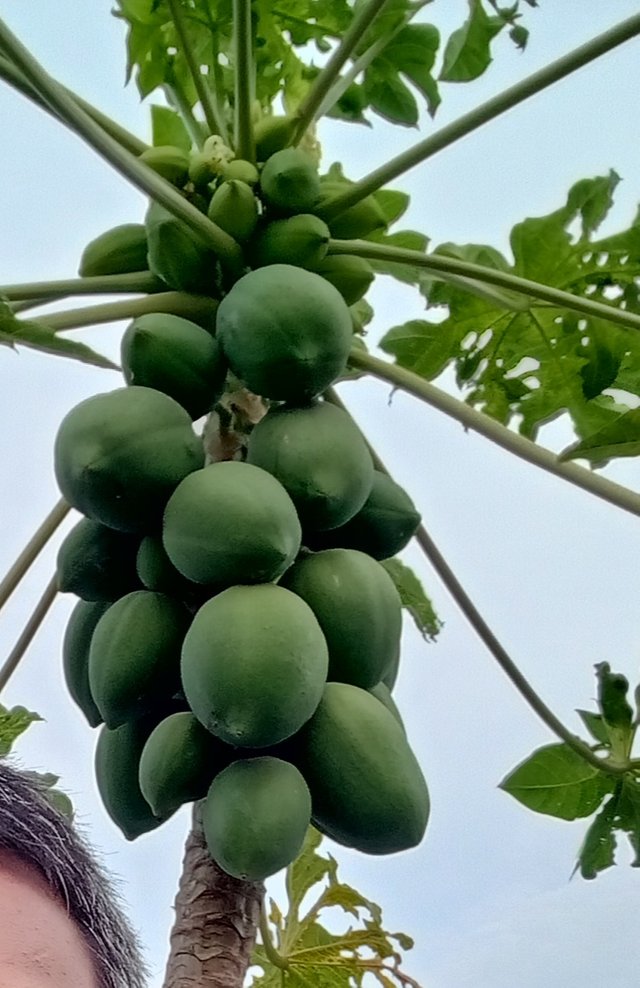Hello friends, hope you all are well and healthy. Be safe, enjoy your life.
The papaya tree is more than 1 year old on the roof of my house. I took the picture with my Realme C21 mobile.

Nutritional value: Ripe papaya is a fruit rich in vitamin A. Raw papaya contains large amounts of a digestive substance called papain.
Herbal Properties: Treats indigestion, worm infections , ulcers, skin sores, eczema, kidney and stomach cancer.
Uses: Ripe papaya is eaten as a fruit and unripe papaya as a vegetable.
Suitable land and soil: High and medium high land is good.
Variety Introduction: Bari Papaya-1 (Royal Papaya): Female and male flowers are borne on separate plants. Flowering occurs 3-4 months after planting. Fruiting starts from the very bottom of the stem. Each fruit weighs 850-950 grams.
Flowering occurs 3-4 months after planting, ripe papayas can be harvested 3-4 months after flowering. This variety bears fruit almost all year round.
Seedling production: Seedlings can be produced from seeds. Mulching in polythene bags promotes rapid growth of seedlings after planting.
Planting: One and a half to two months old seedlings are planted. 15 days before planting, manure should be mixed in the soil of the hole by making a hole of 2 feet at a distance of 2 meters. 50 cm drain should be kept between the two rows for water drainage. The square system is followed for commercial papaya cultivation. 3 to 4 plants should be planted in each hole.
45-day-old papaya seedlings should be planted in large 20" tubs or 2' wide plastic drums on the roof of the house.
Flowering actually leaves 1 female plant and the remaining plants need to be removed. 10% male plants should be kept in the garden to facilitate pollination.
Fertilizer management: 15 kg of organic fertilizer, 550 g of urea fertilizer, 550 g of TSP fertilizer, 550 g of MOP fertilizer, 250 g of gypsum fertilizer, 25 g of borax fertilizer and 20 g of zinc sulfate fertilizer should be applied well together per plant. All fertilizers except urea and MOP fertilizers should be applied at the time of hole making. After planting, when new leaves appear on the plant, 50 grams of urea and MOP fertilizer should be applied every 1 month. This level is doubled when the plant flowers.
Interim care: When fruiting from the flower is sure, one fruit should be left in a bud and the rest should be plucked. Trees should be tied with bamboo poles so that they do not break in storms.
Irrigation and Weed Management: Water as required after planting and application of fertilizers. Light irrigation should be done after 10 to 15 days during dry season.
Disease Management:
Disease Name: Damping of Papaya.
Introduction: This disease can be caused by soil-borne fungi. This disease usually occurs at: seedling stage or during seed germination. The germs of this disease easily attack the seeds or sprouts during the germination of the seeds.
Pattern of damage: In this condition, the seeds rot and seedlings fail to emerge above the soil. In this way, the sprouts can rot before they sprout. Bacterial attack occurs even after germination.At this stage, the root of the seedling rots and the affected seedling falls to the ground and dies. As the age of the seedling increases, the incidence of this disease decreases.
Favorable environment: Incidence of downy mildew is very high during Bursa season.
Spread: The germs of this disease are spread by rain water or irrigation water.
Management: Good root drainage should be maintained. Diseased seedlings should be uprooted from the ground and burned. If the infestation is high, Ridomil MZ-72 should be mixed at the rate of 2 grams per liter of water and applied to the soil around the base of the plant every 7 days. When mosaic symptoms occur due to zinc deficiency, root application of 5-10 grams of zinc per plant and foliar spraying of 0.2% zinc reduces the problem.
Harvesting: Young fruits are harvested as vegetables. For ripening, the skin of the fruit should be collected when it turns light yellow.
Data source: sis.gov.bd
I post a different kind of new idea every day on Steemit, and here I learn new things every day, it's a very happy day for me. I thank the Steemit community for giving us this platform.
Thank you, friend!


I'm @steem.history, who is steem witness.
Thank you for witnessvoting for me.
please click it!
(Go to https://steemit.com/~witnesses and type fbslo at the bottom of the page)
The weight is reduced because of the lack of Voting Power. If you vote for me as a witness, you can get my little vote.
Downvoting a post can decrease pending rewards and make it less visible. Common reasons:
Submit
Thanks for voting me . And I also voted to you (@steem.history).
Downvoting a post can decrease pending rewards and make it less visible. Common reasons:
Submit